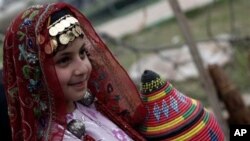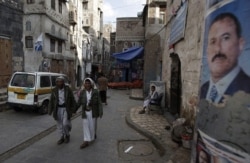While the conflict in Yemen continues to make headlines, a group of 16 Yemeni volunteers is seeking to put the war-torn country in a positive light by presenting its rich history and culture.
The activists started their initiative, Yemen Used to Be, in 2019 on social media platforms and recently launched a website to expand their outreach. With the motto “There’s no present without a past, and there’ll be no fruitful future if its seeds aren’t planted in the present,” the group says it wants to change the way people think about Yemen.
“We felt that it is part of our responsibility to make people see Yemen’s beauty as we Yemenis see it,” Waleed al-Ward, a member of the initiative, told VOA. “We want to introduce the beauty of our country to the world.”
Al-Ward, 23, an undergraduate art and design student at the Royal Academy of Arts in The Hague, works online with the group’s other members across Yemen to collect the stories of the country’s citizens. The team also introduces Yemeni artwork, culture and historical achievements through documentaries.
Online project grows
Ahmed Alhagri, a Yemeni photographer and moviemaker who founded the group in 2019, began the project by simply sharing content on Instagram and Facebook. He soon found wide support from people inside Yemen and around the Arab world. Many urged him to collaborate with artists and storytellers across Yemen to preserve its national heritage.
Prior to the formation and official launch of the initiative, Alhagri and al-Ward were in Sanaa, where they took photos and videos to document their history and Yemeni traditions. Their work stopped quickly in 2015 when the civil war that began in late 2014 shut down most cultural and historical sites.
A part of the team’s effort now is to spread awareness among regular Yemenis about the importance of preserving their artifacts.
“We believe that such realization of the importance of the shared history among Yemenis will help erase the contentions among Yemenis,” al-Ward said.
The group is working to build an archive of key Yemeni historical sites, influential figures, former traditions and native foods. To make sure their audience is well-engaged, they accompany their stories with graphic illustrations based on evidence from Yemeni websites, local libraries, and interviews with experts and local Yemenis.
Chronicling heritage
One of the group’s projects involved documenting the traditions of Jewish weddings in Yemen that have been lost throughout the decades. The team obtained some old footage of the celebrations from abandoned videos on Yemeni Jewish songs, clothes, food and rituals. They say the rendered videos are presented to the Yemeni public to show the beauty of diversity and coexistence in the history of their country.
“The song in the video is a folk song in Yemen, and it is performed by a Jewish artist with Yemeni origins, Ofra Haza,” al-Ward said.
Jews are believed to have lived in Yemen for about 3,000 years and survived continued persecution until their mass movement to Israel in 1949-50 in Operation Magic Carpet. Today, a very small Jewish community remains in the country despite its vulnerability to conflict.
Preserving history
Fierce battles have destroyed several historical locations, with both parties exchanging blame for the loss. In 2018, the International Committee for Red Cross (ICRC) warned that battles between warring parties in the historical city of Zabid, where most of the historical mosques of Yemen are located, threatened to destroy the city’s architecture.
Torrential rains and floods also endanger some of Yemen’s national historical treasures, including the 2,500-year-old old city in the Houthi-held capital, Sanaa, which is on the World Heritage List of the U.N. Educational, Scientific and Cultural Organization (UNESCO).
The U.N. agency has condemned the destruction of historical sites and warned against more damage as the war continues to rage on.
According to Abdullah Alsmat, Yemeni archeologist and executive manager of the Arsh Balqees Organization, or Queen of Sheba’s Throne for Tourism and Heritage, more than 622 historical locations have been destroyed during fire exchange or by airstrikes.
“In 2015, an airstrike by the Saudi-led coalition totally destroyed Dhamar museum where12,000 archaeological objects were kept,” Alsmat said, adding that “Yemen’s artifacts are also lost in looting and smuggling, environmental causes like floods and erosion, in addition to the lack of awareness among Yemenis to the importance of preserving their heritage.”
Initiatives need money, support
Some governmental and nongovernmental organizations are attempting to prevent further damage through different initiatives, according to Alsmat. However, these efforts remain limited mainly because of lack of funding and support.
“The initiatives to preserve Yemen’s heritage are few, but it is better to light a candle than to curse the darkness,” he said, adding that “Yemeni heritage is not just for Yemenis but a human heritage that should be preserved and protected as a part of the history of humanity.”
During six years of war, over 100,000 civilians and combatants were killed in Yemen as peace talks between the government forces and Houthi rebels reached a standstill. According to the World Food Program (WFP), 24 million people in the country need humanitarian assistance, over 3 million are internally displaced and 20 million are food insecure.










